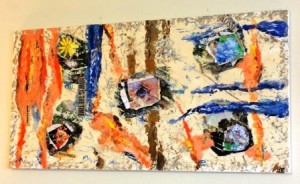“As teachers we need to know what interests [students], what they love so as to turn such interests into education growth in knowledge and positive attitudes.” -Bruce Hammonds

Why is an abstract, multi-media piece of art posted in today’s blog about differentiated instruction? Keep reading…
Yesterday, as I began my workday and was pondering how to answer middle school and high school teacher requests, my mind was elsewhere. (Are you picturing some of your students right now?) I knew I needed to get to work, but I was staring at the portion of my office I call my “art studio.” Okay, it’s really just a cabinet and some storage tubs, but studio sounds so much more elegant. The fresh tubes of acrylic paint, jars of thickening paste, and blank canvas were “calling my name.”
I have been developing ideas for a piece for several months. The piece had to pull together multiple ideas and varied mediums. This week all the pieces of the puzzle came together. The sketches were complete and the supplies were gathered. My interest that morning was in the art work, not in activities for Tabor Rotation.
In her study to see if differentiated instruction would have a positive effect on students, Jeanette Della Vedova found
“For differentiation to work, teachers must put the needs of their students first. The classroom and everything within it must be geared toward a student-centered environment.”
On a weekday, I rarely drop everything and create, but I need to “walk the talk” of differentiated instruction. If I firmly believe that a teacher should build on the interests of the students, then I have to build on my own interests.
“In any classroom, it is critically important that the task we ask students to do is respectful – that it is challenging, interesting, and worth doing… Jerome Bruner proved that when interest is tapped, learning is more likely to be rewarding and the student becomes a more autonomous learner.” -Differentiation Central [http://www.differentiationcentral.com/whatisdi.html]
I spent hours completely oblivious to time. I was so engaged I forgot about everything else but the composition and creation of the painting. I was highly motivated to finish the piece and I did. That evening everyone else was in bed and the painting was drying. I sat on a chair nearby and my brain began to make natural connections from my art to the secondary teachers’ requests for more activities on area and perimeter. My mind was so much at ease and so saturated with personal fulfillment that the connection was immediately made. The same thing happens with students when we build on their interests and passions—their minds are open and receptive to knowledge!!!
My understanding of form, balance, shape, and area were used the entire time I was working on the piece. I never completed a textbook page on area, but I knew how much acrylic paint, gesso, and thickening paste was needed to cover the canvas. There wasn’t a worksheet on perimeter, but I knew the amount of jute and acrylic paint needed to form the mixed-hue “frame” around the edge of the canvas. I was engaged because I was interested. I worked hard, not because someone was giving me a sticker or points, but because I wanted to see the completed project. The entire time I was working with geometric concepts. Again, this engagement will occur in the classroom when interest becomes a primary consideration when flexibly grouping.
“Whenever possible, the children’s ideas and interests should provide the basis for the content.” -Staab
Having fun with something that interested me will help provide activities for area and perimeter. More than that, it gave me a renewed energy and a sense of satisfaction that being creative always gives. Again, what does this have to do with differentiated instruction?
“In a differentiated classroom, a teacher sees everything a student says or creates as useful information both in understanding that particular learner and in crafting instruction to be effective for that learner…All students consistently work with “respectful” activities and learning arrangements. This important principle provides that every learner must have tasks that are equally interesting and equally engaging, and which provide equal access to essential understanding and skills. In differentiated classrooms, a teacher’s goal is that each child feels challenged most of the time;” from “Leadership for Differentiated Schools and Classrooms” by Tomlinson & Allen
I’ll post the activities next week. For now, I’m looking at a rectangular piece of canvas which may not make sense to others, but will inspire me for a very, long time!
“Only those who will risk going too far can possibly find out how far one can go.” -T. S. Eliot


Wow. As co-founder of +Works (www.positivethinkingworks.org), a new non-profit focused on motivating communities to get ahead of America’s bullying epidemic with positive talk and action, I see so much potential in applying Glenna’s creative principals to what we are endeavoring to do in our organization.
Reaching your audience in a way that is relevant yet unexpected is so important — whether you’re teaching math, speaking on a tough topic like bullying or guiding your own children after they’ve had a challenging day. How do we break through and reach individuals in a creative and compelling way? By being open about the best way to work ourselves, as Glenna demonstrates so well in this piece, we have a better chance of discovering our most innovative solutions. Giving ourselves permission to pursue creative activities or anything that fills our souls — even if these activities impinge, in the short-term, on time given to our daily professional duties — is important not only for balance, but for professional growth.
Go Glenna — and thanks for the professional inspiration. I’m off to my easel!!